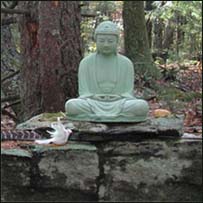|
|
 |

|

|

|
The greatest gift is the
gift of the teachings
|
|

|
| |
|
Dharma Talks
|
2009-07-16
Growing a True Face
24:19
|
|
Ajahn Sucitto
|
|
|
A lot of practice is about working with difficult mind states, emotional currents, and personality patterns. With the establishment of basic ground, we bring together a unified Dhamma body that holds us steady. It gives us a reference point, a presence, that drains power out of the hindrances and allows us to meet difficulties that arise.
|
|
Cittaviveka
:
Vassa Retreat
|
|
|
2009-06-02
Appreciative Joy
44:02
|
|
Shaila Catherine
|
|
|
Appreciative joy (sympathetic joy, mudita) is the third of four qualities called Brahma Viharas (divine abodes) which are the subjects for this 4-part lecture series. Appreciative joy is presented as an extension of the loving kindness (metta) practice. Joy refers to the ability to delight and rejoice in the success and good fortune of others. Mudita overcomes the hindrances and obstacles of conceit, comparing, envy, avarice, jealousy, aversive criticism, resentment, competitiveness, and boredom.
|
|
Insight Meditation South Bay - Silicon Valley
:
Four Brahma Viharas
|
|
In
collection:
Four Brahma Viharas
|
|
|
2009-05-12
Factors That Support and Hinder Concentration
58:22
|
|
Sally Armstrong
|
|
|
Any time we practice mindfulness and wise attention, we are weakening the impact of the hindrances, and strengthening what are known as the five jhanic factors: meditative qualities that support the continuity and deepening of our meditation. Each of the jhanic factors actually balances and acts as an antidote to one of the hindrances. This talk looks at how to strengthen the jhanic factors, and use them skillfully as antidotes to the hindrances.
|
|
Spirit Rock Meditation Center
:
Concentration Retreat
|
|
|
2009-03-16
Stay Tuned - Radiant Mind Untainted By Ego
26:45
|
|
Ayya Medhanandi
|
|
|
We hear in the Udana, Verses of Uplift, about the Venerable Meghiya’s wish to practise in the beautiful Mango Grove before his mind was mature enough. Even when we are on retreat and conditions for practice seem perfect, hindrances plague the mind and overcome it with impurities. So we hold fast to the Buddha’s instructions to know for ourselves the radiance of mind that is untainted by ego.
|
|
Ottawa Buddhist Society
|
|
|
2009-01-06
Themes of meditation
30:49
|
|
Ajahn Sucitto
|
|
|
Through referencing the parable of the cook (S.47:8), we are encouraged to get to know the mind in order to choose the meditation theme that suits it best. There are a range of themes you can use to counteract hindrances: such as death contemplation, unattractiveness of the body, lovingkindness, Buddha and breathing. Through trial and error, find out what is needed.
|
|
Cittaviveka
:
Winter Retreat
|
|
|
2007-10-16
The Hindrances: Doubt
41:30
|
|
Shaila Catherine
|
|
|
Doubt can be an obstacle to meditation or a form of healthy inquiry. It is helpful to ask questions, to ponder, and be willing to doubt our beliefs and opinions. Ask yourself: are my views true? We hold many unexamined beliefs—beliefs about self, about how things should be, about what other people should do. The Kalama Sutta encourages us to question what we think, and to not adopt beliefs based on hearsay or mere tradition. We can use our minds to critically inquire into how things actually are. Doubt as an obstacle, on the other hand, is a painful state that leads to confusion, fear, indecision, and uncertainty. It manifests as obsessive thinking, planning, and anxiety. The Discourse to Malunkyaputta (Middle Length Discourses, M. 63) proposes that if we indulge in speculative thinking we might miss the opportunity to free ourselves from suffering. Specific suggestions are offered for working skillfully with the hindrance of doubt.
|
|
Insight Meditation South Bay - Silicon Valley
:
Tuesday Talks
|
|
|
2007-10-09
Hindrances, Restlesness
44:05
|
|
Andrea Fella
|
|
|
The hindrance of restlessness and remorse is a fundamental hindrance out of which the other hindrances can arise. The importance of becoming familiar with restlessness, to see or understand its nature, is discussed. Through having a clear understanding of how it arises in the mind and in the body one can work with its various manifestations in practice.
|
|
Insight Meditation South Bay - Silicon Valley
|
|
|
|
|